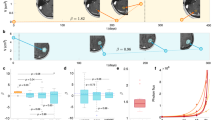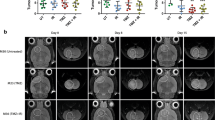Abstract
The aim of our study is to characterize the disturbance induced by repeated BCNU treatments in 12 human brain tumor cell lines in terms of their collective behavior. This collective behavior was characterized by means of the Delaunay triangulation and Voronoi mathematical paving techniques combined with the computer-assisted microscope analysis of Feulgen-stained nuclei. This methodology enabled growth to be characterized in terms of cell colony size and density. In addition to this colony pattern characterization, the DNA ploidy level was assessed by means of DNA histogram typing. The cell proliferation level was also determined. Ten astrocytic and two medulloblastoma cell lines treated weekly with BCNU were analyzed. Study of the cell colony architecture and cell proliferation revealed specific BCNU-induced modifications in connection with the origins of the cell lines, i.e. astrocytoma (AST), glioblastoma (GBM), or medulloblastoma (MED). The BCNU-induced effect on GBM (the more malignant of the cell lines) was very different in that proliferation was weakened, but the cell colony density increased after a latency phase. The decrease in cell colony density and cell proliferation of MED seems to indicate that they are more sensitive to BCNU than GBM, but relatively tolerant of this type of chemotherapy in comparison with AST.
Similar content being viewed by others
References
Fine HA, Dear KBG, Loeffler JS, Black PM, Canellos GP: Meta-analysis of radiation therapy with and without adjuvant chemotherapy for malignant gliomas in adults. Cancer 71: 2585–2597,1993
Rutka JT, Smith SL: Transfection of human astrocytoma cells With glial fibrillary acidic protein complementary DNA: Analysis of expression, proliferation, and tumorigenicity. Cancer Res 53: 3624–3631, 1993
Kleihues P, Burger PC, Scheithauer BW. Histological typing of the tumours of the central nervous system. Edition 2. Springer-Verlag, 1992
Daumas-Duport C, Scheithauer BW, Kelly PJ: A histologic and cytologic method for the spatial definition of gliomas. Mayo Clin Proc 62: 435–449, 1987
Brandes A, Soesan M, Fiorentino MV: Medical treatment of high grade malignant gliomas in adults: an overview. Cancer Res 11: 719–728, 1991
Chabner BA, Collins JM: Cancer chemotherapy: Principles and practice. J.B. Lippincott Company, Philadelphia, 1990
Tannock IF, Hill RP: The basic science of oncology. Edition 2. McGraw-Hill, 1992
Miller BE, Machemer T, Lchotan M, Heppner GH: Tumor subpopulation interactions affecting melphalan sensitivity in palpable mouse mammary tumors. Cancer Res 51: 4378–4387, 1991
Darro F, Kruczynski A, Etievant C, Martinez J, Pasteels JL, Kiss R: Characterization of the differentiation of human colorectal cancer cell lines by means of Voronoi diagrams. Cytometry 14: 783–792, 1993
Camby I, Etienvant C, Petein M, Dedecker R, Van Velthoven R, Danguy A, Pasteels JL, Kiss R: Influence of culture media on the morphological differentiation of the PC-3 and DU145 prostatic neoplastic cell lines. Prostate 24: 187–196, 1994
Salmon I, Kiss R: Relationship between proliferative activity and ploidy level in a serie of 530 human brain tumors including astrocytomas, meningiomas, Schwannomas and metastases. Human Path 24: 329–335, 1993
Pauwels O, Kiss R, Atassi G: Computer-assisted microscope analysis of morphonuclear modifications induced by anti-cancer antimetabolites in cell lines cultured in vitro. Anti-Cancer Drugs 5: 160–170, 1994
Stratton MR, Darling J, Pilkington GJ, Lantos PL, Reeves BR, Cooper CS: Characterization of the human cell line TE671. Carcinogenesis 10: 899–905, 1989
Camby I, Salmon I, Rorive S, Gras T, Darro F, Kruczynski A, Danguy A, Pasteels JL, Kiss R: Characterization of the influence of anti-hormone and/or growth factor neutralizing antibodies on cell clone architecture and the growth of human neoplastic astrocytic cell lines. J Neurooncol 20: 67–80, 1994
Kiss R, Salmon I, Camby I, Gras S, Pasteels JL: Characterization of factors in routine laboratory protocols that significantly influence the Feulgen reaction. J Histochem Cytochem 41: 935–945, 1993
Mousseau M, Chauvin C, Nissou MF, Chaffanet M, Plamaz D, Pasquier B, Schaerer R, Benabid A: A study of the expression of four chemoresistance-related genes in human primary and metastatic brain tumours. Eur J Cancer 29a: 753–755, 1993
Packer RJ: Chemotherapy for medulloblastoma/primitive neuroectodermal tumors of the posterior fossa. Ann Neurol 28: 823–828, 1990
Da Silva VS, Feeley M, Raaphorst GP: Hyperthermic potentiation of BCNU toxicity in BCNU-resistant human glioma cells. J Neurooncol 11: 37–41, 1991
Etievant C, Kruczynski A, Pauwels O, Kiss R: The combination of the Tetrazolium derivative reduction (MTT) and digital cell image analysis to monitor in vitro the cytotoxicity of anti-neoplastic drugs. Anticancer Res 11: 305–312, 1991
Shapiro JR, Pu PY, Mohamed AN, Galicich JH, Ebrahim SAD, Shapiro WR: Chromosome number and carmustine sensitivity in human gliomas. Cancer 71: 4007–4021, 1993
Norton L, Surbone A: Principles of chemotherapy: Cytokinetics. In: Holland JF, Frei E, Bast RC, Kufe DW, Morton DL, Weichselbaum RR (eds) Cancer Medicine, Edition 3, Lea and Febiger, page 609, 1993
Goldie JH, Coldman AJ: A mathematical model for relating the drug sensitivity of tumors to their spontaneous mutation rate. Cancer Treat Rep 63: 1727–1733, 1979
Frankfurt OS, Seckinger D, Sugarbaker EV: Intercellular transfer of drug resistance. Cancer Res 51: 1190–1195, 1991
Miller BE, Miller FR, Heppner GH: Interactions between tumor subpopulations affecting their sensitivity to the antineoplastic agents cyclophosphamide and methotrexate. Cancer Res 41: 4378–4381, 1981
Tofilon PJ, Buckley N, Deen DF: Effect of cell-cell interactions on drug sensitivity and growth of drug-sensitive and-resistant tumor cells in spheroids. Science 226: 862–864, 1984
Yung WK, Shapiro JR, Shapiro WR: Heterogeneous chemosensitivities of sub-populations of human glioma cells in culture. Cancer Res 42: 992–998, 1982
Salmon I, Levivier M, Camby I, Rombaut K, Gras T, Pasteels JL, Brotchi J, Kiss R: Assessment of nuclear size, nuclear DNA content and proliferation index in stereotaxic biopsies from brain tumours. Neuropathol Appl Neurobiol 19: 507–518, 1993
Jacobsen AB, Pettersen EO, Amellem O, Berner A, Ous S, Fossa SD: The prognostic significance of deoxyribonucleic acid flow cytometry in muscle invasive bladder carcinoma treated with preoperative irradiation and cystectomy. J Urol 147: 34–37, 1992
Shapiro JR, Ebrahim SAD, Mohamed AN, Pu PY, Shapiro WR: BCNU-sensitivity in parental cells and clones from four freshly resected near-diploid human gliomas: An astrocytoma, an anaplastic astrocytoma and two glioblastomas multiforme. J Neurooncol 15: 209–227, 1993
Pienta KJ, Ward WS: An unstable nuclear matrix may contribute to genetic instability. Medical Hypothesis 42: 45–52, 1995
Teicher BA: Hypoxia and drug resistance. Cancer Metas Rev 13: 139–168, 1994
Eyfjörd JE, Thorlcius S, Steinarsdottir M, Valgardsdottir R, Ögmundsdottir M, Anamthawat-Jonsson K: p53 abnormalities and genomic instability in primary human breast carcinomas. Cancer Res 55: 646–651, 1995
Livingstone LR, White A, Sprouse J, Livanos E, Jacks T, Tisty TD: Altered cell cycle arrest and gene amplification potential accompany loss of wild-type p53. Cell 70: 923–935, 1992
Koga H, Zhang S, Kumanishi T et al.: Analysis of p53 gene mutation in low- and high-grade astrocytomas by polymerase chain reaction-assisted single-strand conformation polymorphism and immunohistochemistry. Acta Neuropathol (Berl) 87: 225–232, 1994
Iuzzolino P, Ghimenton C, Nicolato A et al.: p53 protein in low-grade astrocytomas: A study with long-term follow-up. Br J Cancer 69: 586–591, 1994
Carder P, Wyllie AH, Purdie CA, Morris RG, White S, Piris J, Bird CC: Stabilised p53 facilitates aneuploid clonal divergence in colorectal cancer. Oncogene 8: 1397–1401, 1993
Owens RB, Smith HS, Nelson-Rees WA, Springer EL: Epithelial cell cultures from normal and cancerous human tissues. J Natl Cancer Inst 563: 843–846, 1976
Fogh J, Fogh JM, Orfeo T: One hundred and twenty-seven cultured human tumor cell lines producing tumors in nude mice. J Natl Cancer Inst 59: 221–225, 1977
Arnstein P, Taylor DON, Nelson-Rees WA, Huebner RJ, Lannette EH: Propagation of human tumors in antithymocyte serum-treated mice. J Natl Cancer Inst 52: 71–81, 1974
Giard DJ, Aaronson SA, Todaro GJ, Arnstein P, Kersey JH, Dosik H, Parks WP: In vitro cultivation of human tumors: establishment of cell lines derived from a series of solid tumors. J Natl Cancer Inst 51: 1417–1423, 1973
Stein GH: T98G: An anchorage-independent human tumor cell line that exhibits stationnary phase G1 arrest in vitro. J Cell Physiol 99: 43–54, 1979
Ponten J, Macintyre EH: Long term culture of normal and neoplastic human glia. Acta Path Microbiol Scandinav 74: 465–586, 1968
Jacobsen PF, Jenkyn DJ, Papadimitriou JM: Establishment of a human medulloblastoma cell line and its heterotransplantation into nude mice. J Neuropathol Exp Neurol 44: 472–485, 1985
Mcallister RM, Isaacs H, Rongey R, Peer M, Au W, Soukup SW, Gardner MB: Establishment of human medulloblastoma cell line. Int J Cancer 20: 206–212, 1977
Author information
Authors and Affiliations
Additional information
I.C. is a Research Assistant with the ‘Fonds National de la Recherche Scientifique’ (FNRS, Belgium)
R.K. is a Research Associate with the FNRS
Rights and permissions
About this article
Cite this article
Camby, I., Salmon, I., Danguy, A. et al. Computer-assisted microscope characterization of BCNU-induced modifications in the collective behavior of 12 human brain cancer cell lines. J Neuro-Oncol 28, 1–11 (1996). https://doi.org/10.1007/BF00300441
Issue Date:
DOI: https://doi.org/10.1007/BF00300441




